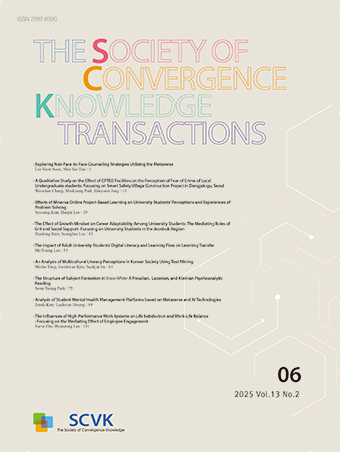Research Article
Abstract
References
Information
화재 안전을 위해서, 화재 발생을 방지하는 것이 가장 근본적인 방법이다. 기상의 변화는 인간의 생활의 변화와 밀접한 관계가 있고, 기상 변화에 따른 화재 발생 예측은 화재 예방을 위해 많은 기여를 할 수 있을 것이다 . 본 연구에서는 예측 기술을 활용하여 기상의 변화에 따른 화재 발생의 변화를 분석하고자 한다. 예측 모델은 온도, 습도, 풍속, 지역의 4가지 입력 변수를 기반으로 하였다. 이러한 기상 조건을 기반으로 화재 유형, 발화원, 발화 원인 및 발화 물질과 같은 여러 화재 특성에 대한 화재 위험 예측 정확도를 확인하였다. 분석을 위해 ‘인구 시간당 화재 발생 빈도’를 산출하고 이를 위험등급으로 구분하는 데이터 전처리를 하였고, 인공신경망과 의사결정트리를 활용한 화재 예측 모형을 만들었다. 분석 결과 세부 변수별 화재 위험도의 예측 정확도를 비교하였고 기상과 연관성이 높은 특정 유형의 화재를 확인하였다. 본 연구는 기상 조건에 따라 화재 발생 위험이 높은 세부 특성을 파악하고 추후 화재 특성별 위험도를 도출하기 위한 기초자료로 활용 가능할 것이다.
For fire safety, preventing the occurrence of a fire is the most fundamental method. Changes in weather are closely related to changes in human life, and prediction of fire occurrence according to changes in weather can make a great contribution to fire prevention. This study intends to analyze the change in fire occurrence according to the change of weather by using the prediction technology. The prediction model’s results were based on 4 input variables (temperature, humidity, wind velocity, and region); it measured the fire-risk prediction accuracy for several fire characteristics such as fire type, ignition source, ignition cause, and ignition material based on those weather conditions. For the analysis, data pre-processing was performed to calculate the ‘population frequency of fires per hour’ and classify them into risk grades, and the fire prediction model using artificial neural networks and decision trees was created. As a result of the analysis, the prediction accuracy of the fire risk for each detailed variable was compared, and a specific type of fire highly related to the weather was identified. This study can be used as basic data to identify detailed fire characteristics with a high risk of fire depending on weather conditions and to derive the risk level for each fire characteristic in the future.
- L. Yang, C. W. W. Dawson, M. R. R. Brown, and M. Gell, "Neural Network and GA Approaches for Dwelling Fire Occurrence Prediction", Knowledge-Based Systems, Vol. 19, pp. 213-219, 2006.https://doi.org/10.1016/j.knosys.2005.11.021
- J. Corcoran, G. Higgs, D. Rohde, P. Chhetri, J. Corcoran, G. Higgs, D. Rohde, and P. Chhetri, "Investigating the Association between Weather Conditions, Calendar Events and Socio-Economic Patterns with Trends in Fire Incidence: An Australian Case Study", Journal of Geographical Systems, Vol. 13, pp. 193-226, 2011.https://doi.org/10.1007/s10109-009-0102-z
- M. Holmes, Y. Wang, and I. Ziedins, "The Application of Data Mining Tools and Statistical Techniques to Identify Patterns and Changes in Fire Events", 2009.
- Z. Wang, X. Zhang, and B. Xu, "Spatio-Temporal Features of China's Urban Fires: An Investigation with Reference to Gross Domestic Product and Humidity", Sustainability, Vol. 7, pp. 9734-9752, 2015.https://doi.org/10.3390/su7079734
- D.-W. Song, K.-S. Kim, and S.-K. Lee, "Statistical Analysis of the Relation between Fire Occurrence and Weather Factors", ISSN International Journal of Engineering and Technology, Vol. 9, pp. 2319-8613, 2017.https://doi.org/10.21817/ijet/2017/v9i2/170902064
- K. D. Kotnour, "Statistics: The Exploration and Analysis of Data", Technometrics, Vol. 30, pp. 460-461, 1988.https://doi.org/10.1080/00401706.1988.10488452
- H. J. Kim, and J. S. Yu, "On a Method for Computing Quantiles of Grouped Data", Journal of The Korean Data Analysis Society, Vol. 10, pp. 3453-3464, 2008.
- P. Cortez, and A. Morais, "A Data Mining Approach to Predict Forest Fires using Meteorological Data", Proc. 13th Port. Conf. Artif. Intell., pp. 512-523, 2007.
- J.-S. Chou, and A.-D. Pham, "Enhanced Artificial Intelligence for Ensemble Approach to Predicting High Performance Concrete Compressive Strength", Construction and Building Materials, Vol. 49, pp. 554-563, 2013.https://doi.org/10.1016/j.conbuildmat.2013.08.078
- X.-H. Meng, Y.-X. Huang, D.-P. Rao, Q. Zhang, and Q. Liu, "Comparison of Three Data Mining Models for Predicting Diabetes or Prediabetes by Risk Factors", The Kaohsiung Journal of Medical Sciences, Vol. 29, pp. 93-99, 2013.https://doi.org/10.1016/j.kjms.2012.08.016PMid:23347811
- D. Delen, G. Walker, and A. Kadam, "Predicting Breast Cancer Survivability: A Comparison of Three Data Mining Methods", Artificial Intelligence in Medicine, Vol. 34, pp. 113-127, 2005.https://doi.org/10.1016/j.artmed.2004.07.002PMid:15894176
- G. K. F. Tso, and K. K. W. Yau, "Predicting Electricity Energy Consumption: A Comparison of Regression Analysis, Decision Tree and Neural Networks", Energy, Vol. 32, pp. 1761-1768, 2007.https://doi.org/10.1016/j.energy.2006.11.010
- L.-J. Wang, M. Guo, K. Sawada, J. Lin, and J. Zhang, "A Comparative Study of Landslide Susceptibility Maps Using Logistic Regression, Frequency Ratio, Decision Tree, Weights of Evidence and Artificial Neural Network", Geosciences Journal, Vol. 20, pp. 117-136, 2016.https://doi.org/10.1007/s12303-015-0026-1
- T. Guo, and J. V Milanovic, "Probabilistic Framework for Assessing the Accuracy of Data Mining Tool for Online Prediction of Transient Stability", IEEE Transactions on Power Systems, Vol. 29, pp. 377-385, 2014.https://doi.org/10.1109/TPWRS.2013.2281118
- M. Jajroudi, T. Baniasadi, L. Kamkar, F. Arbabi, M. Sanei, and M. Ahmadzade, "Prediction of Survival in Thyroid Cancer Using Data Mining Technique", p. 13, 2014.https://doi.org/10.7785/tcrt.2012.500384PMid:24206207
- Y. Zhu, C. Xie, B. Sun, G.-J. Wang, and X.-G. Yan, "Predicting China's SME Credit Risk in Supply Chain Financing by Logistic Regression, Artificial Neural Network and Hybrid Models", Sustainability, Vol. 8, p. 433, 2016.https://doi.org/10.3390/su8050433
- C. R. Jennings, "Social and Economic Characteristics as Determinants of Residential Fire Risk in Urban Neighborhoods: A Review of the Literature", Fire Safety Journal, Vol. 62, pp. 13-19, 2013.https://doi.org/10.1016/j.firesaf.2013.07.002
- Publisher :The Society of Convergence Knowledge
- Publisher(Ko) :융복합지식학회
- Journal Title :The Society of Convergence Knowledge Transactions
- Journal Title(Ko) :융복합지식학회논문지
- Volume : 9
- No :3
- Pages :81-88
- DOI :https://doi.org/10.22716/sckt.2021.9.3.031




 The Society of Convergence Knowledge Transactions
The Society of Convergence Knowledge Transactions







